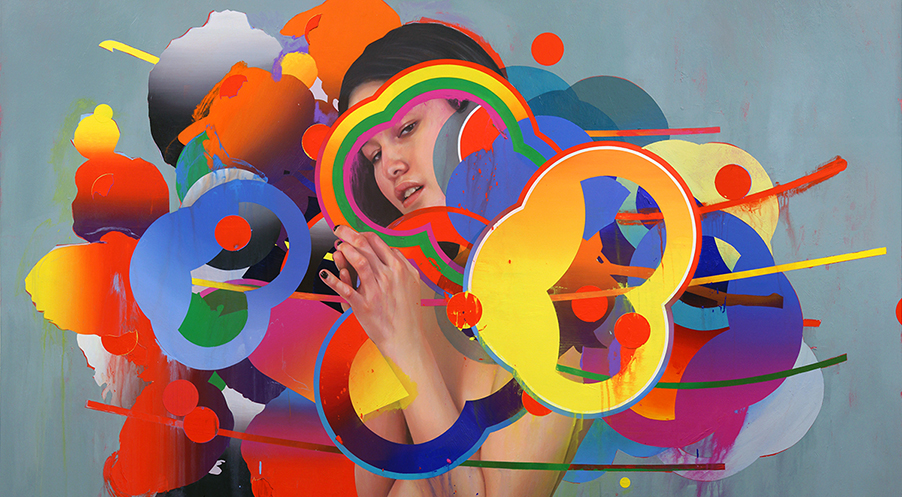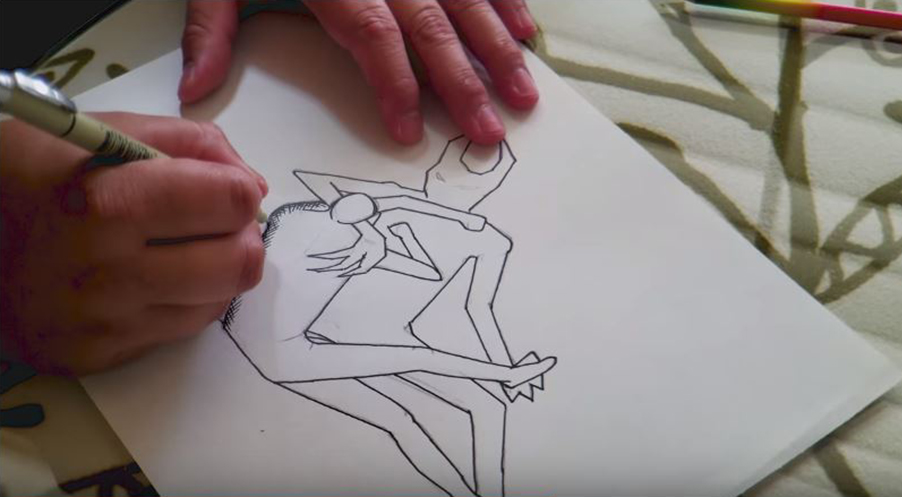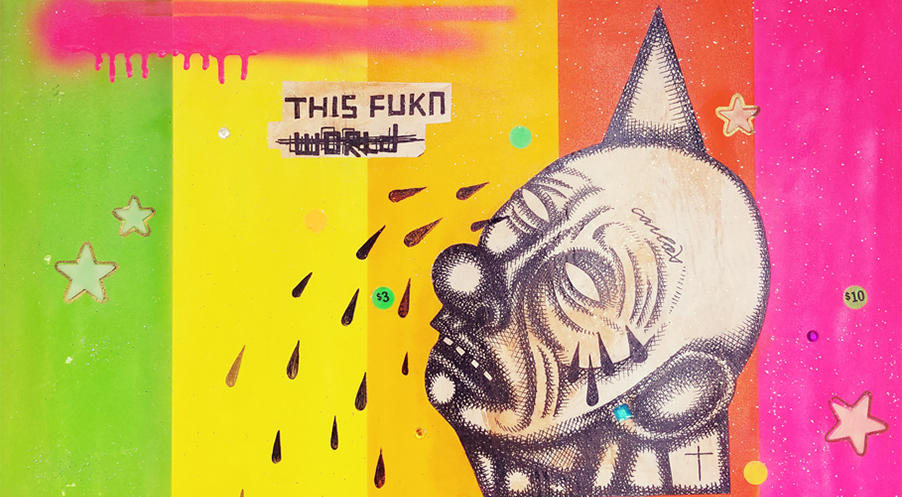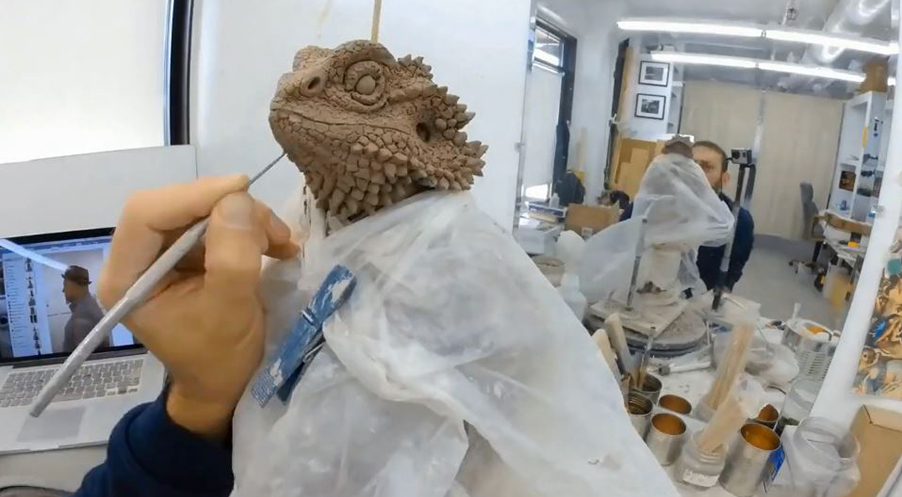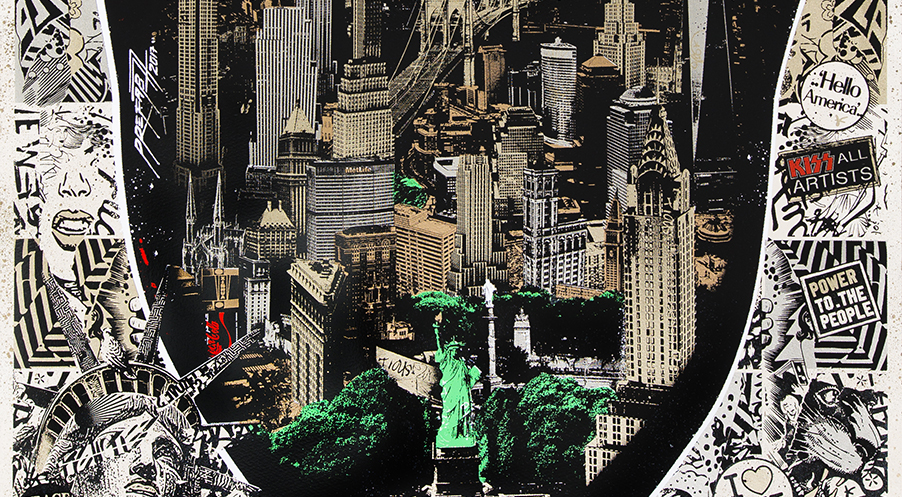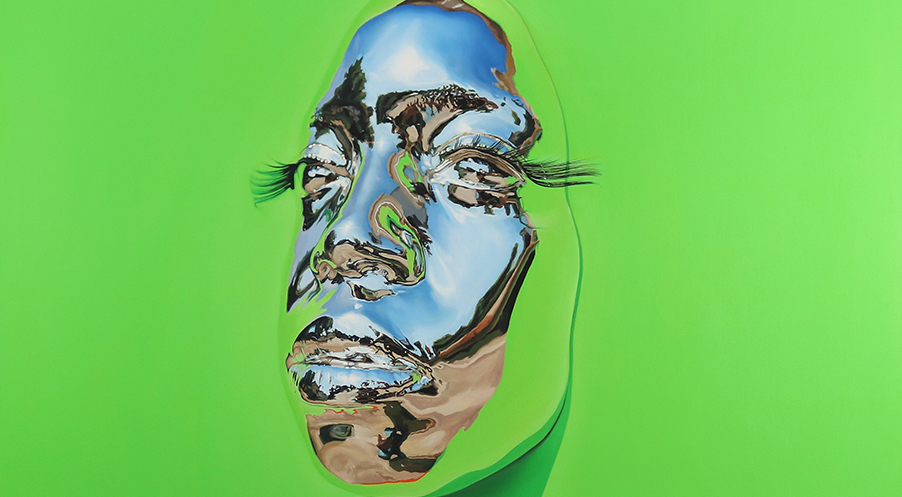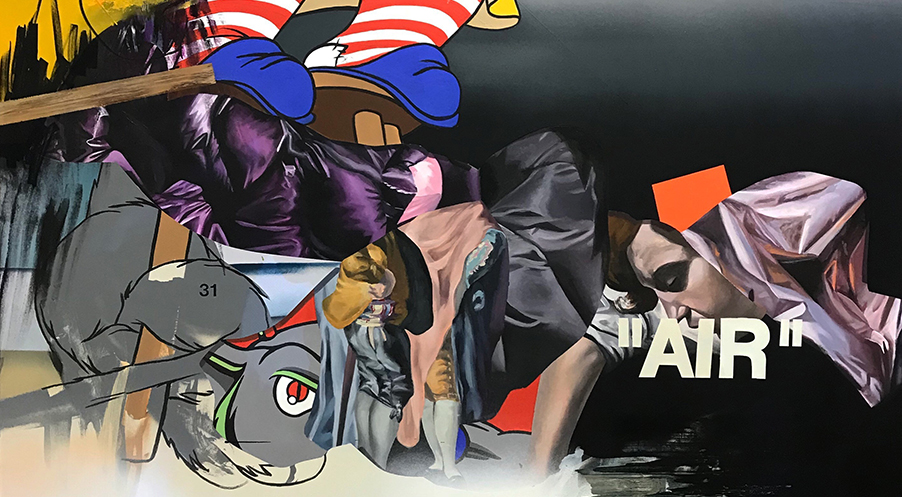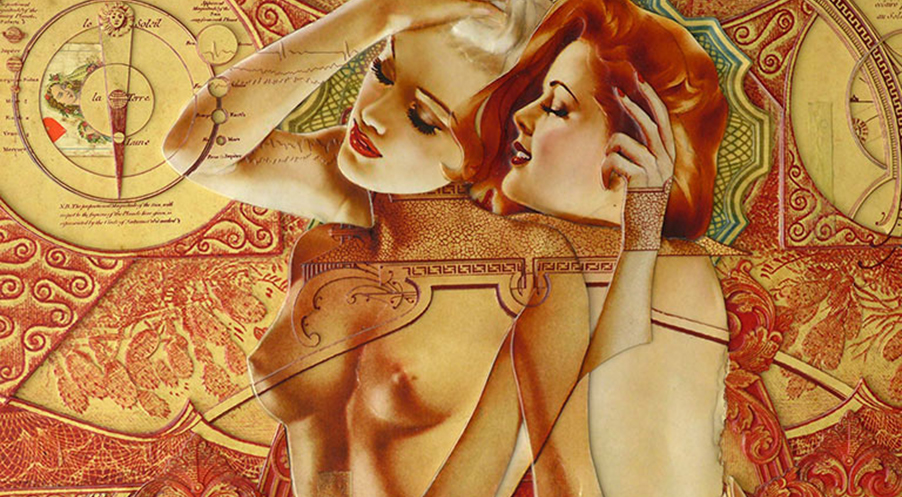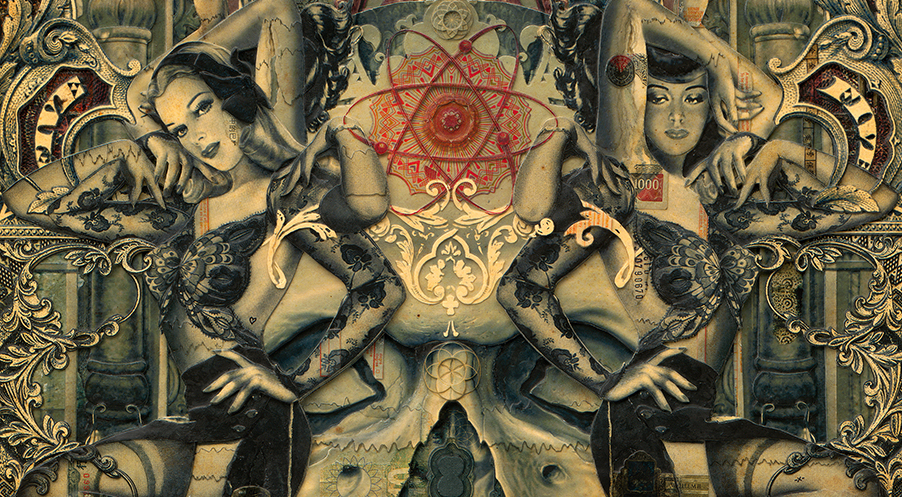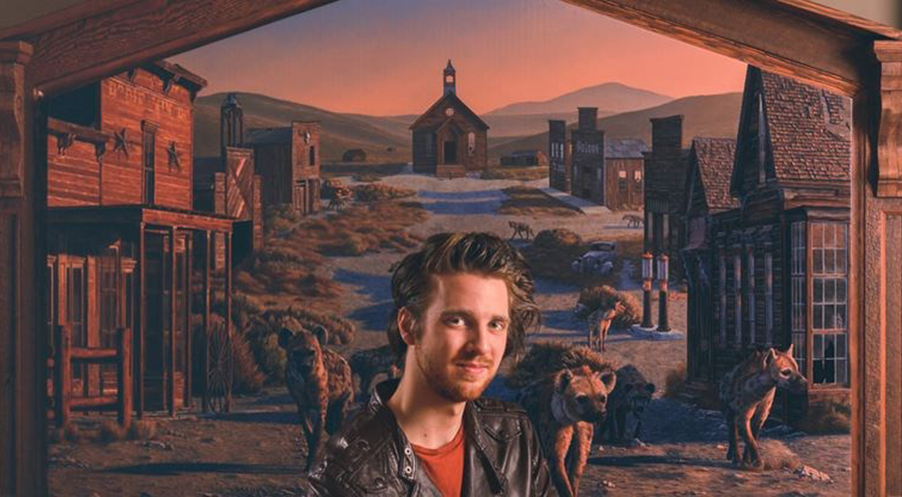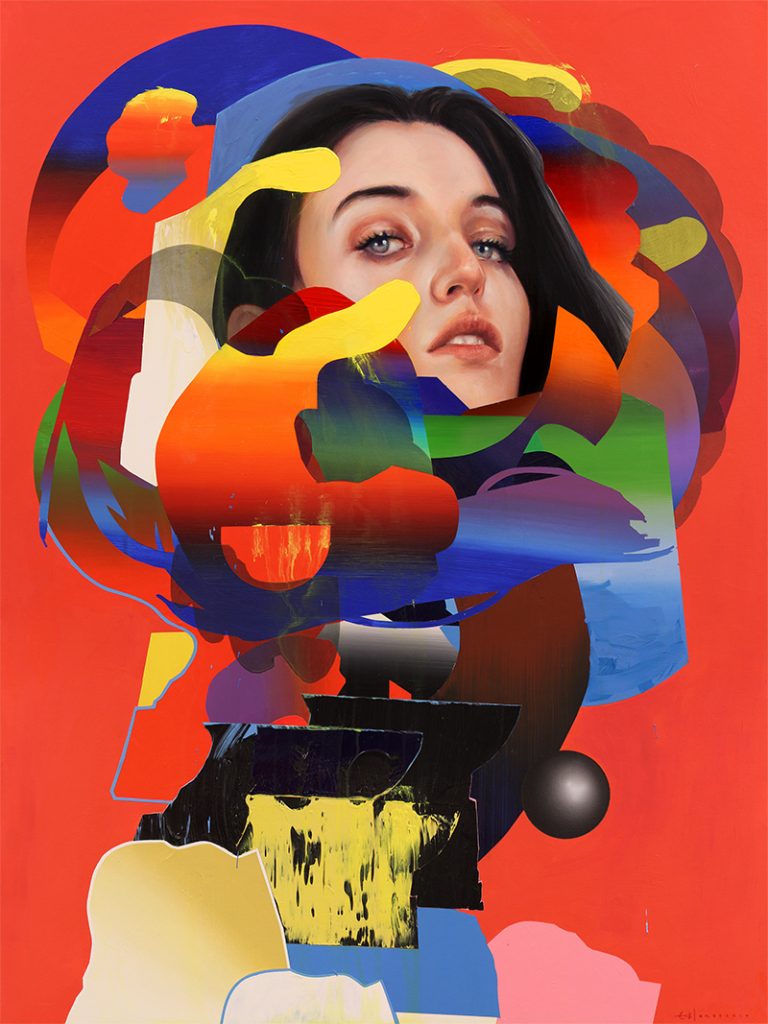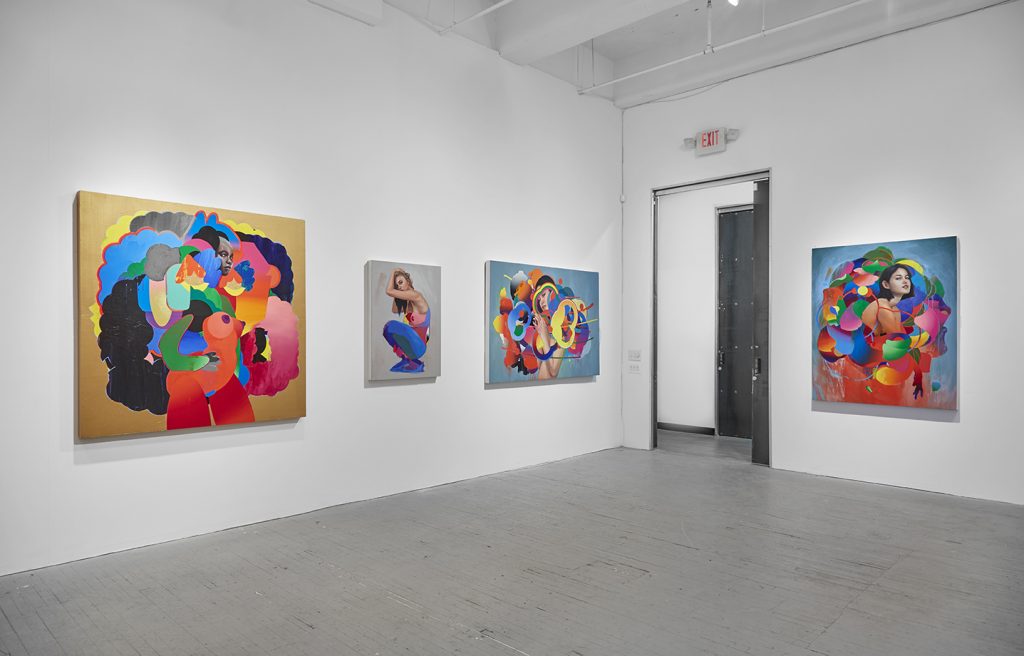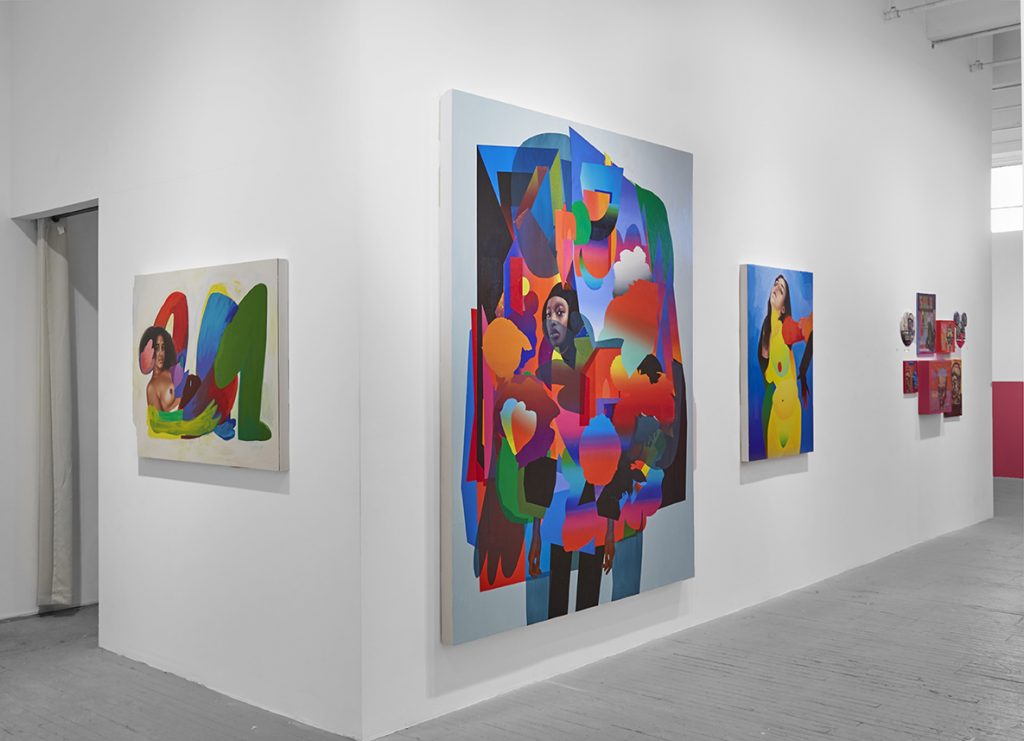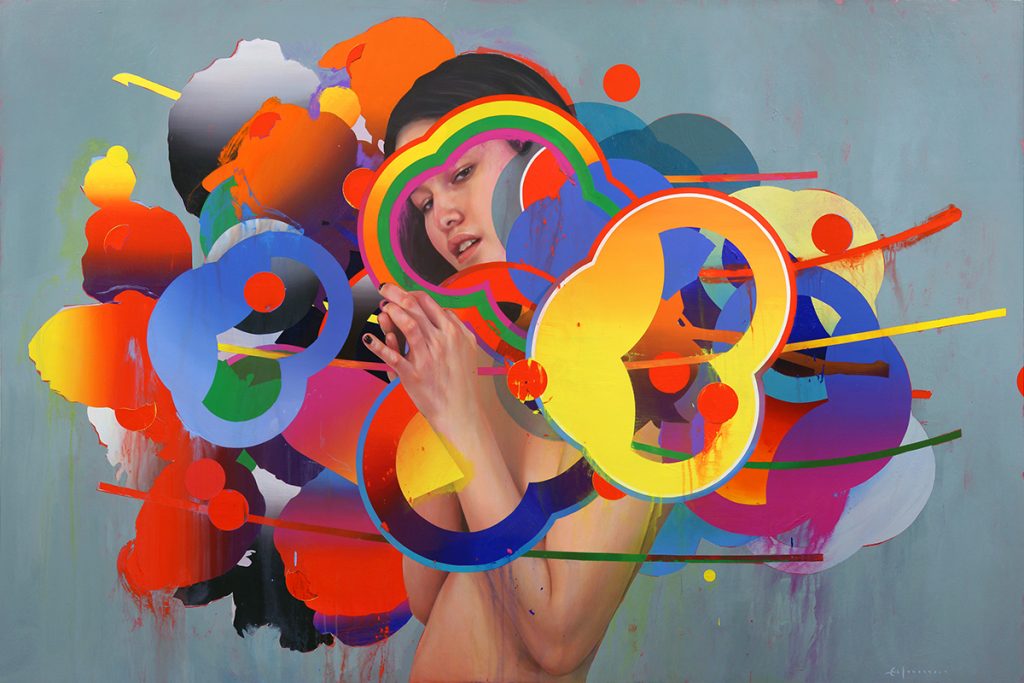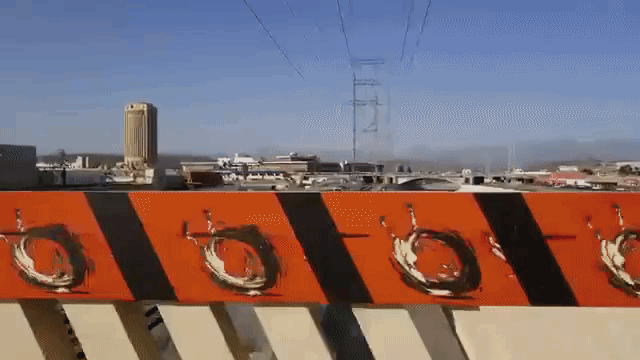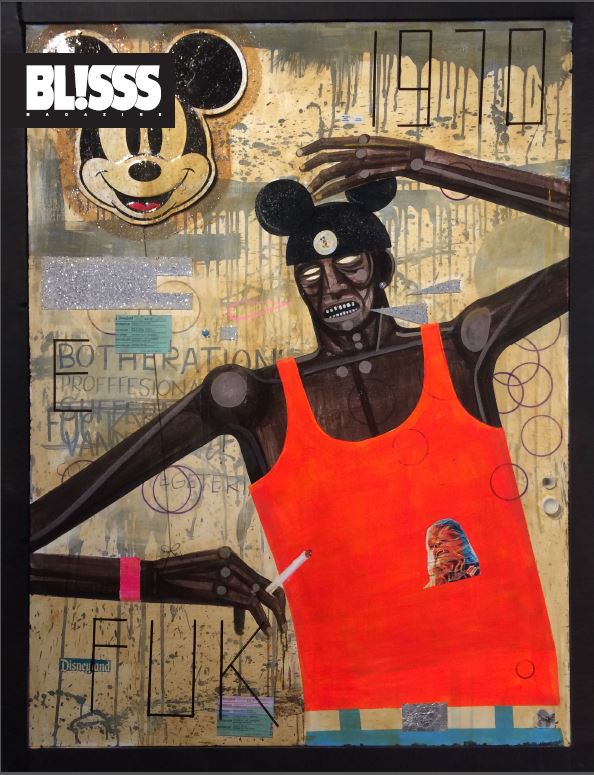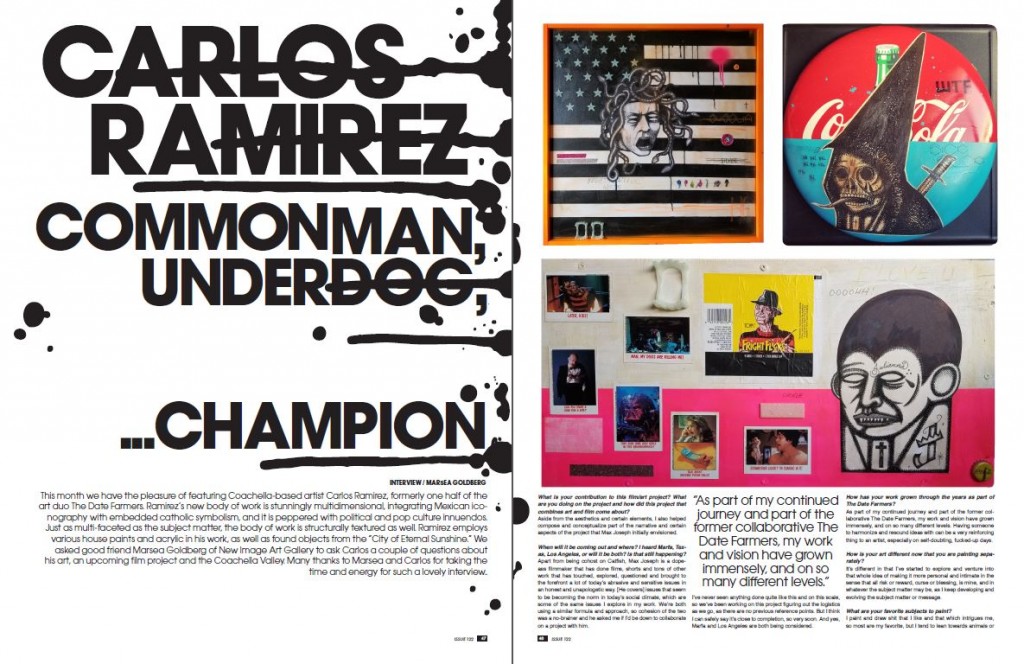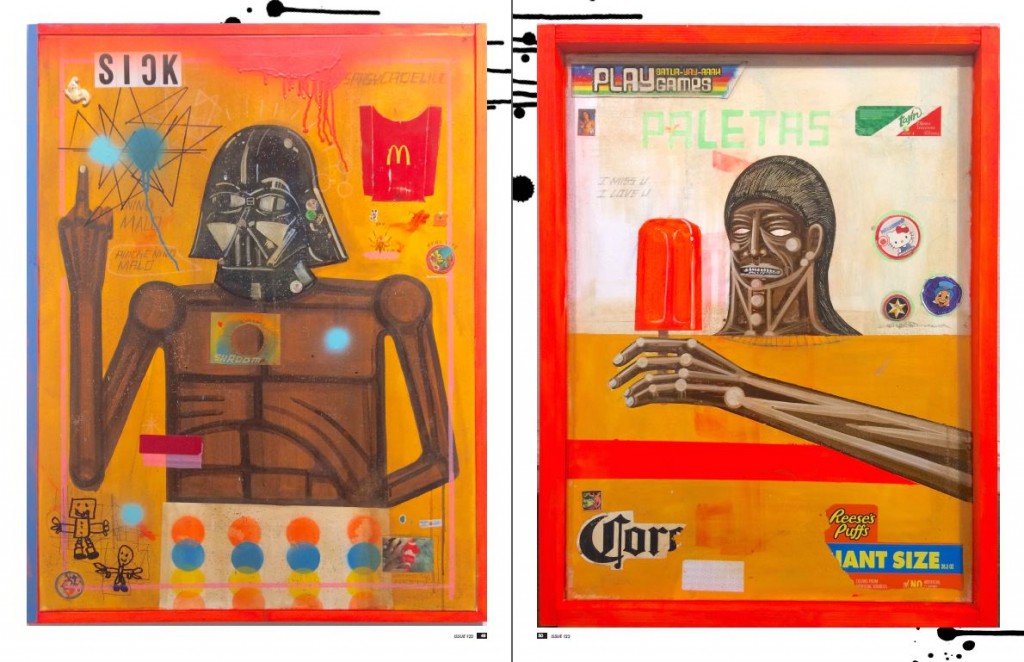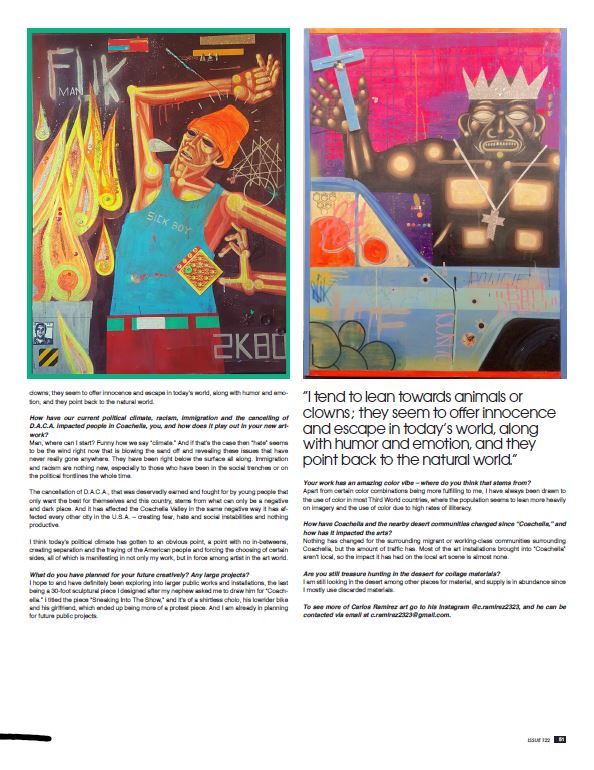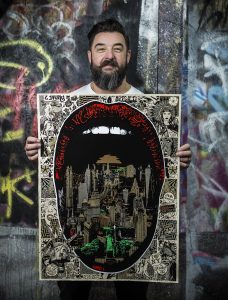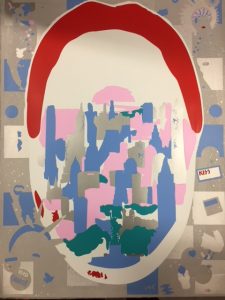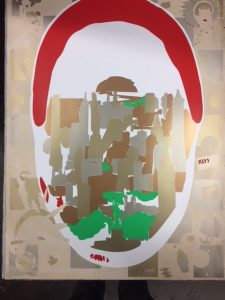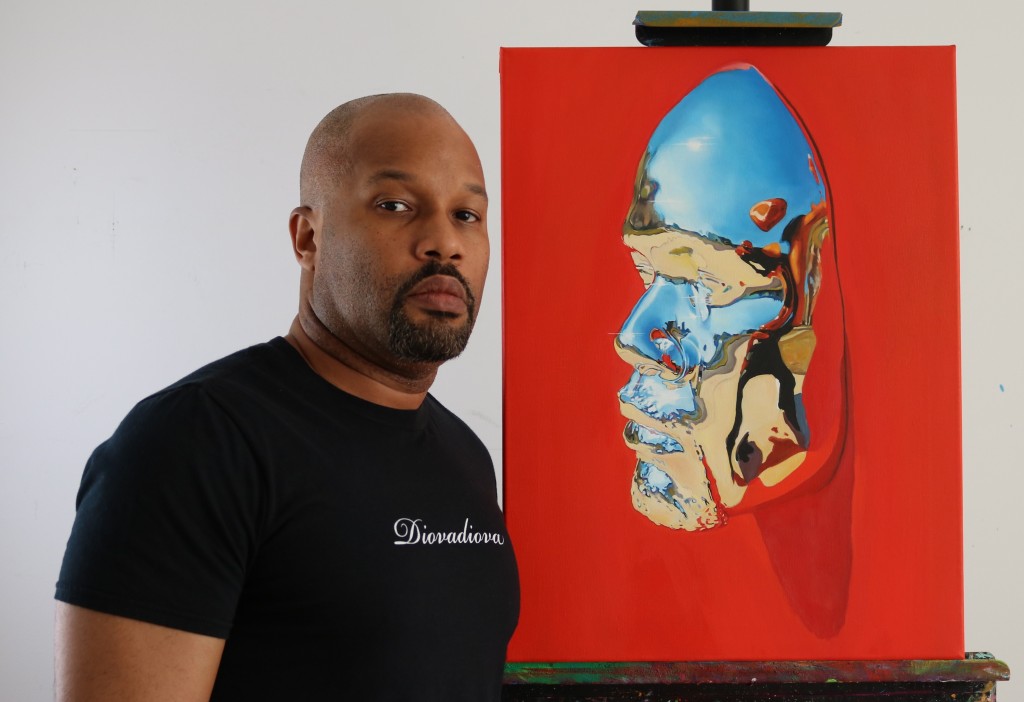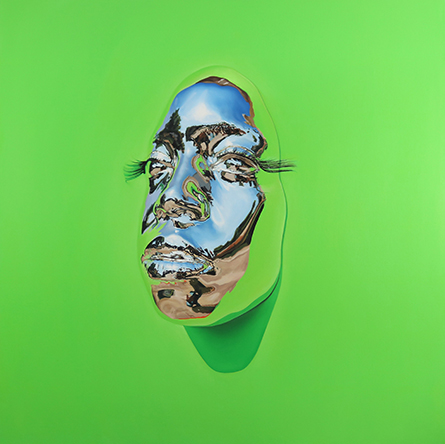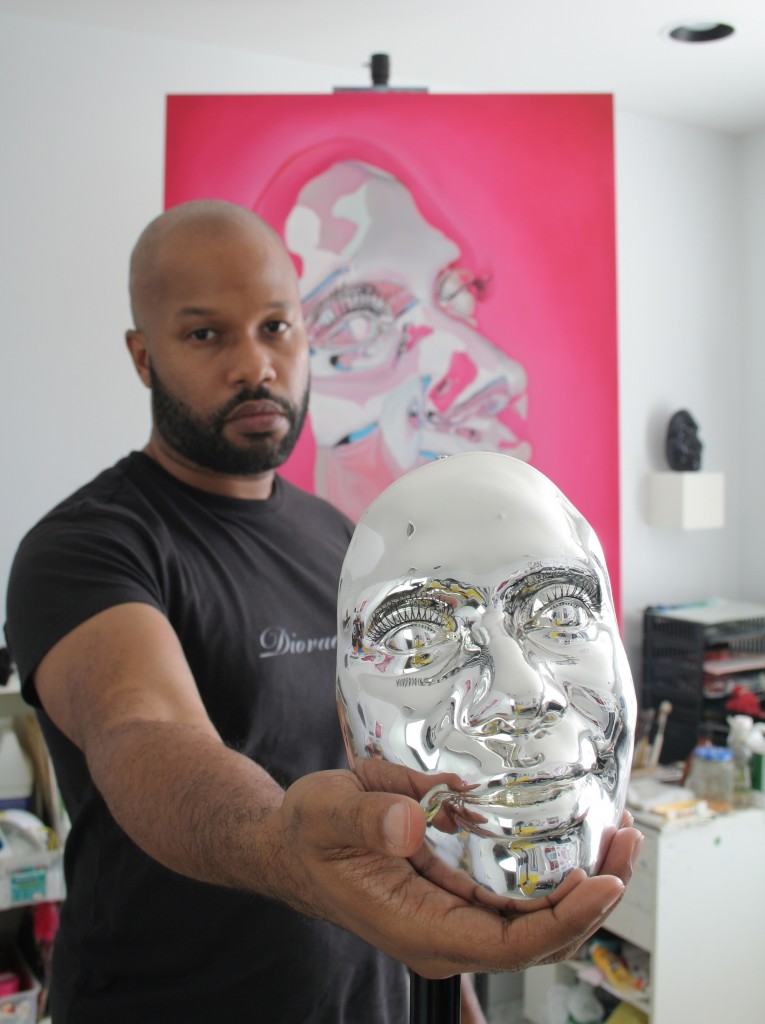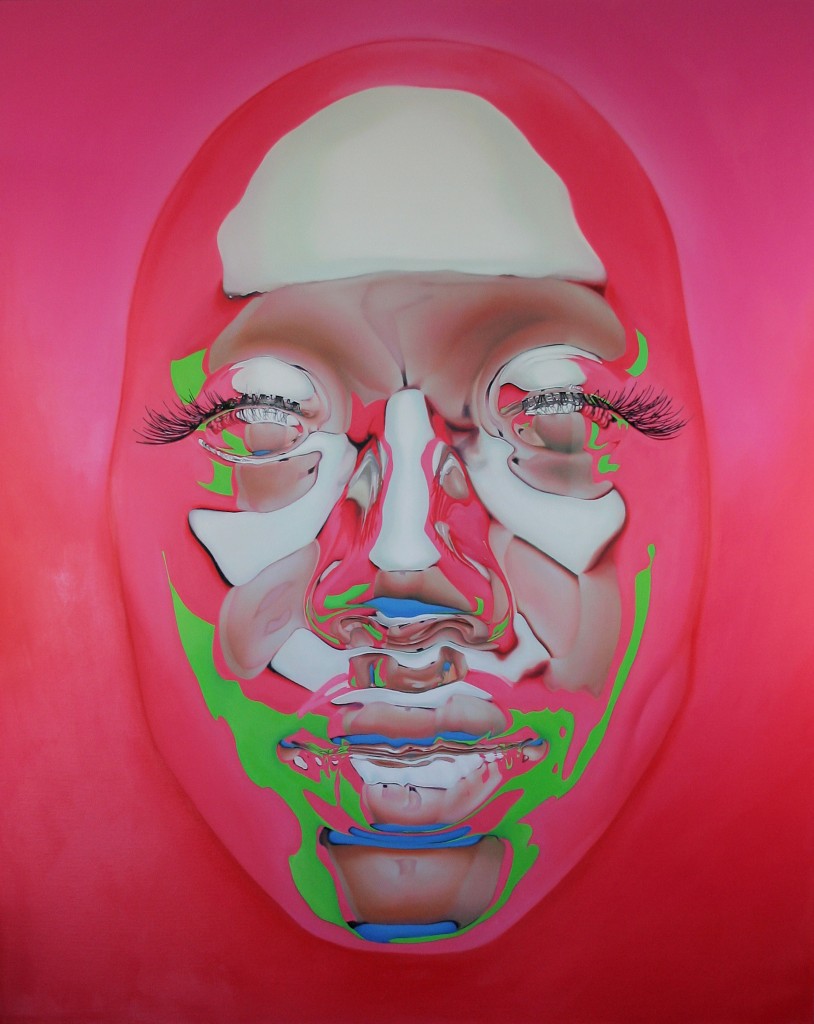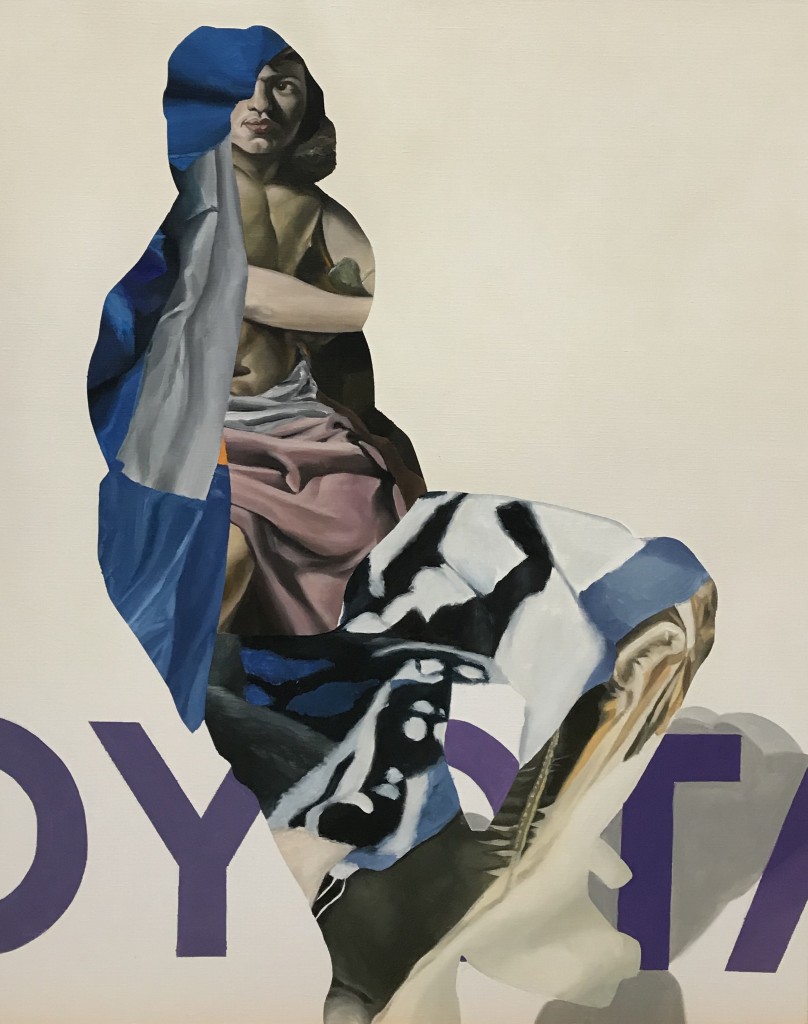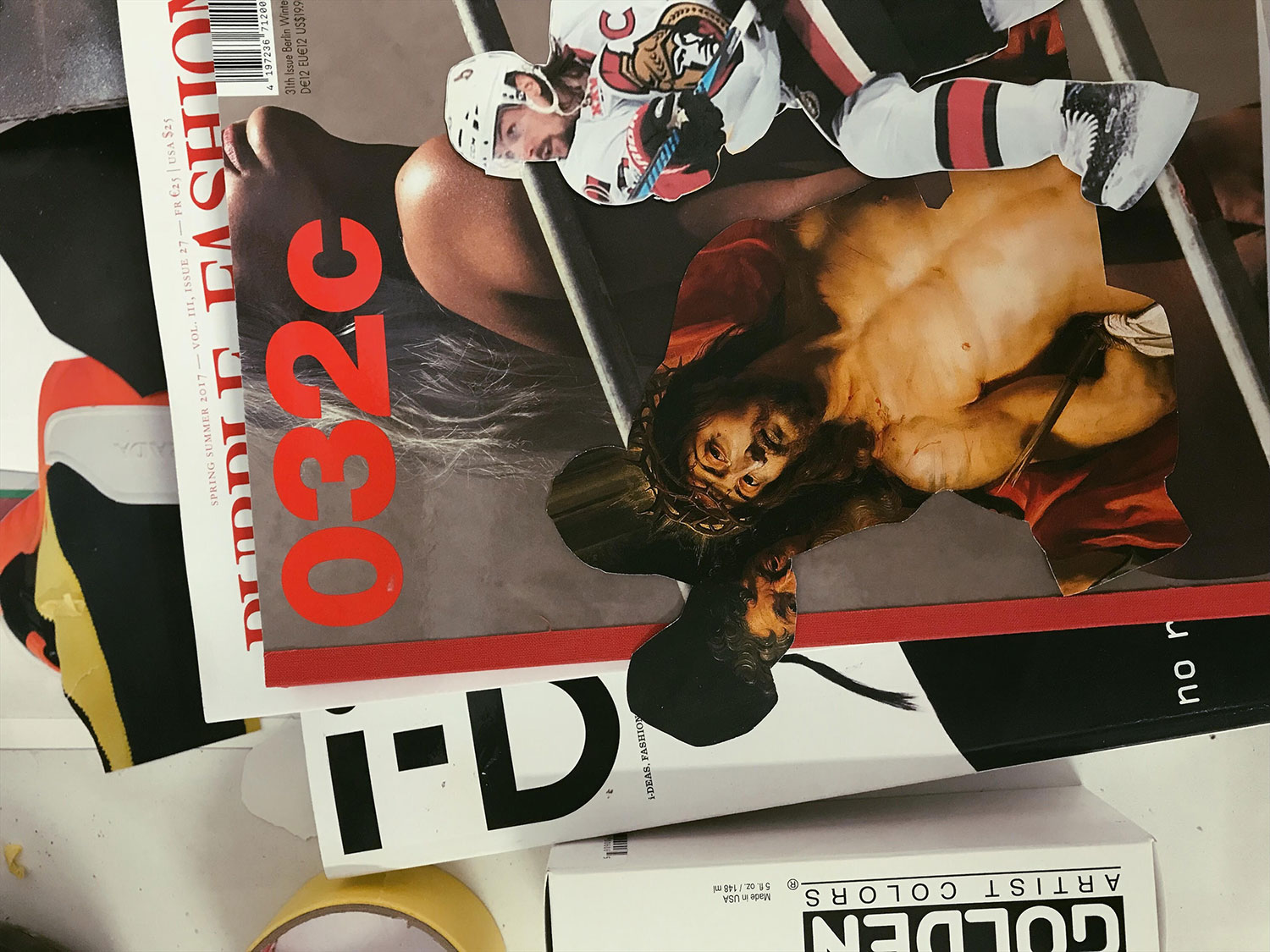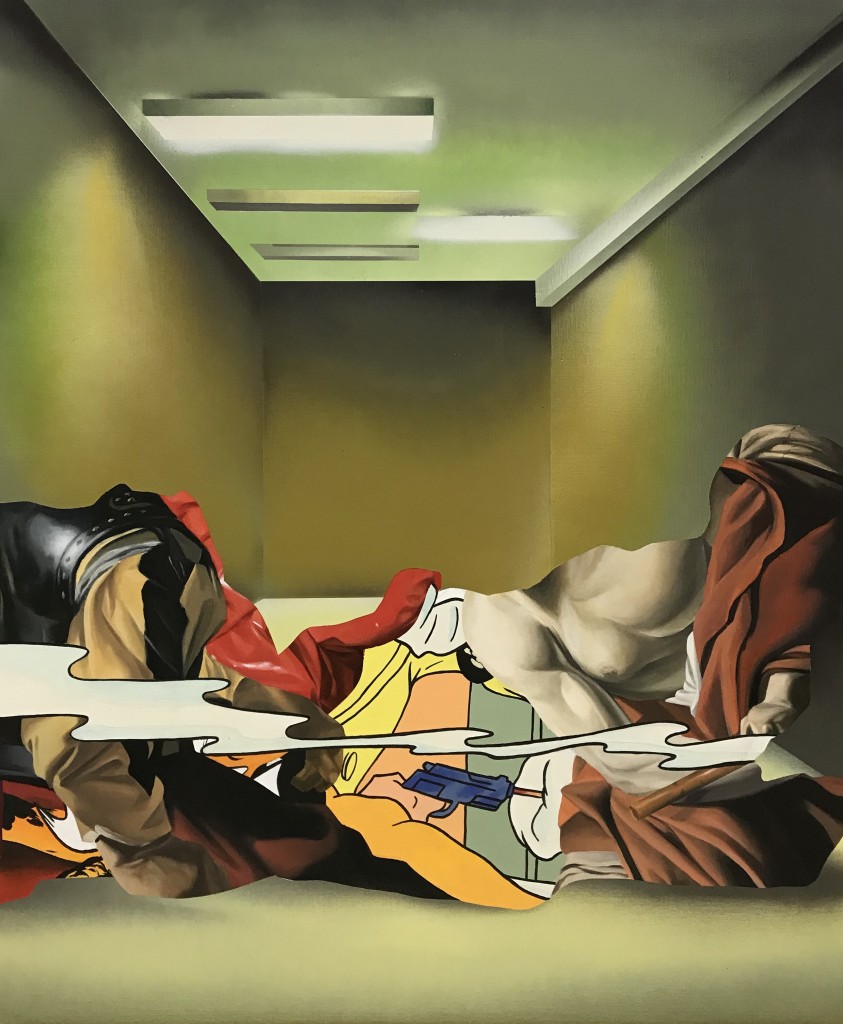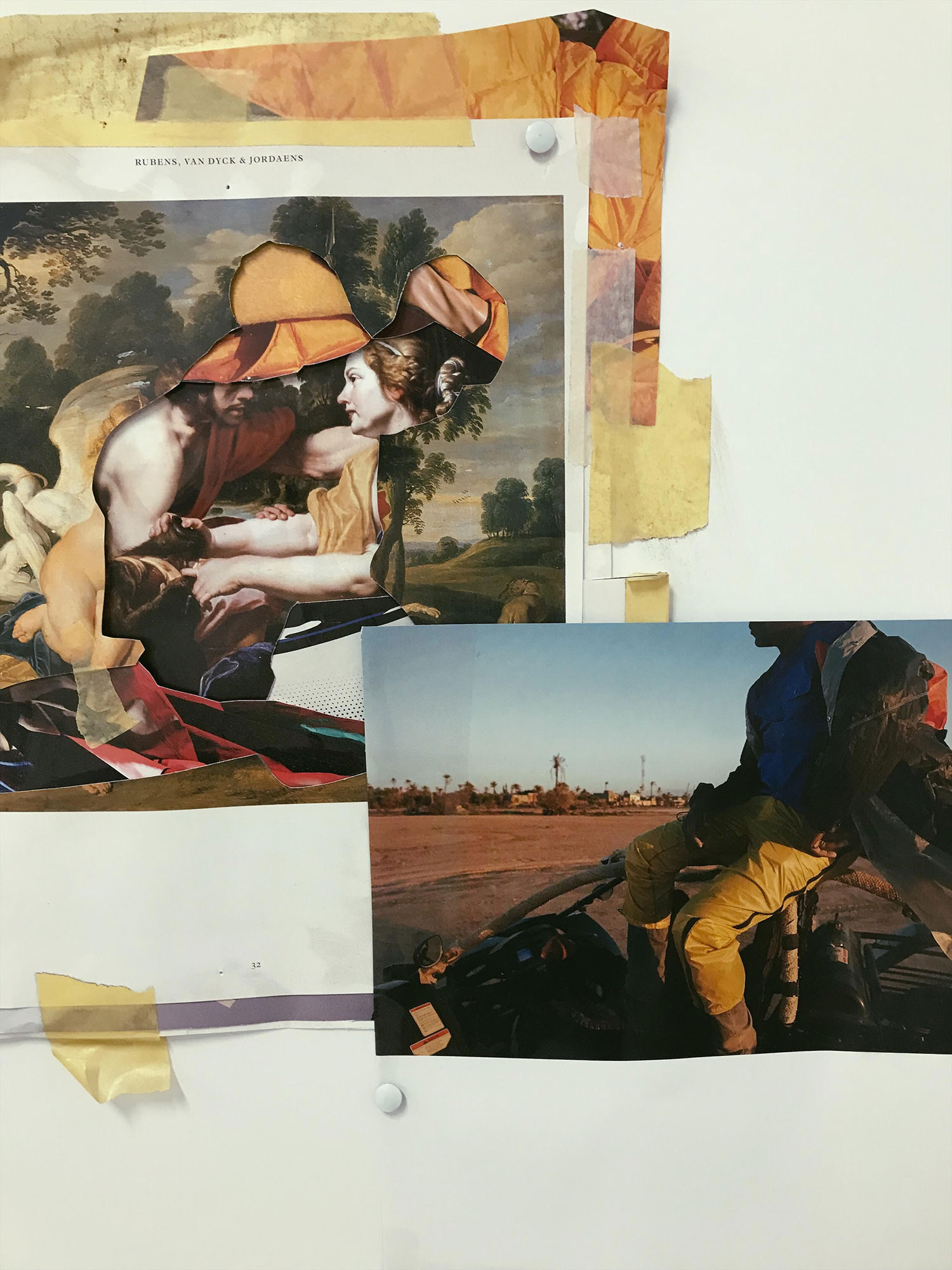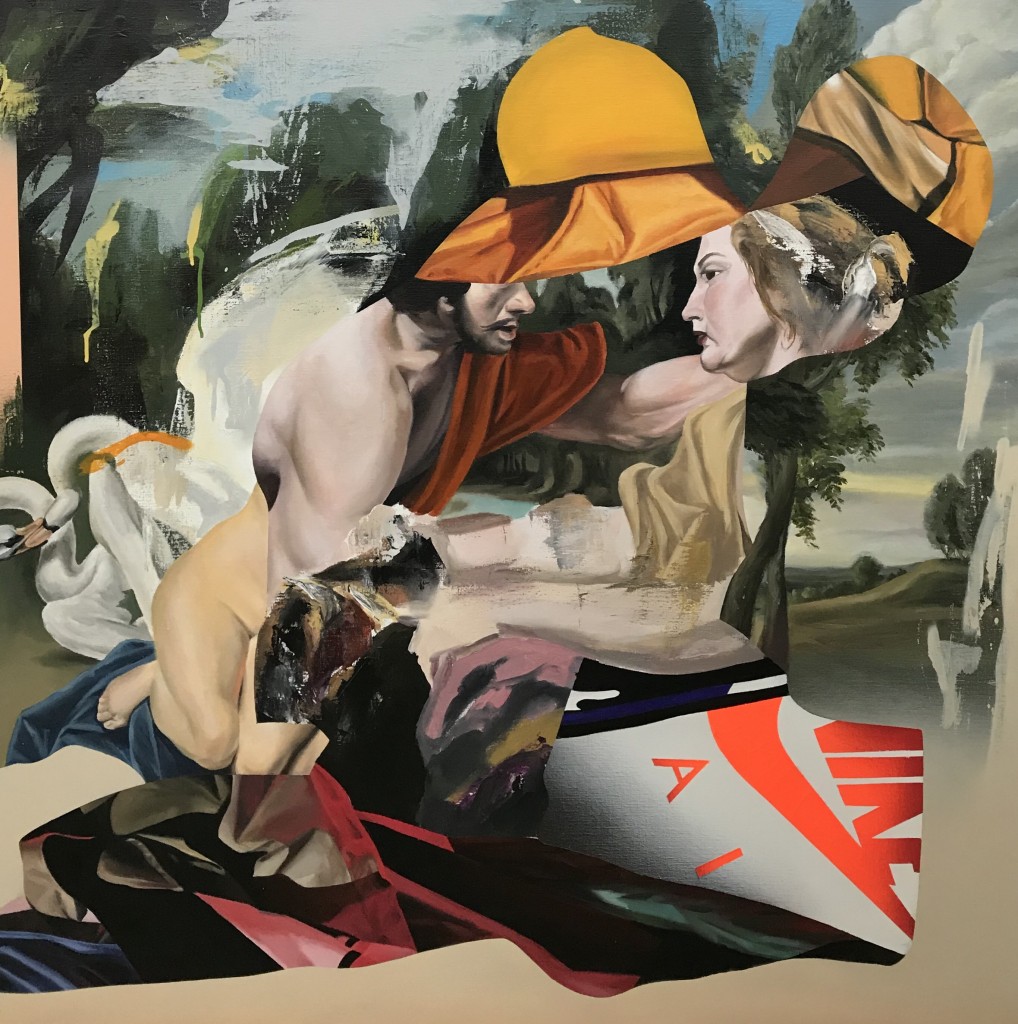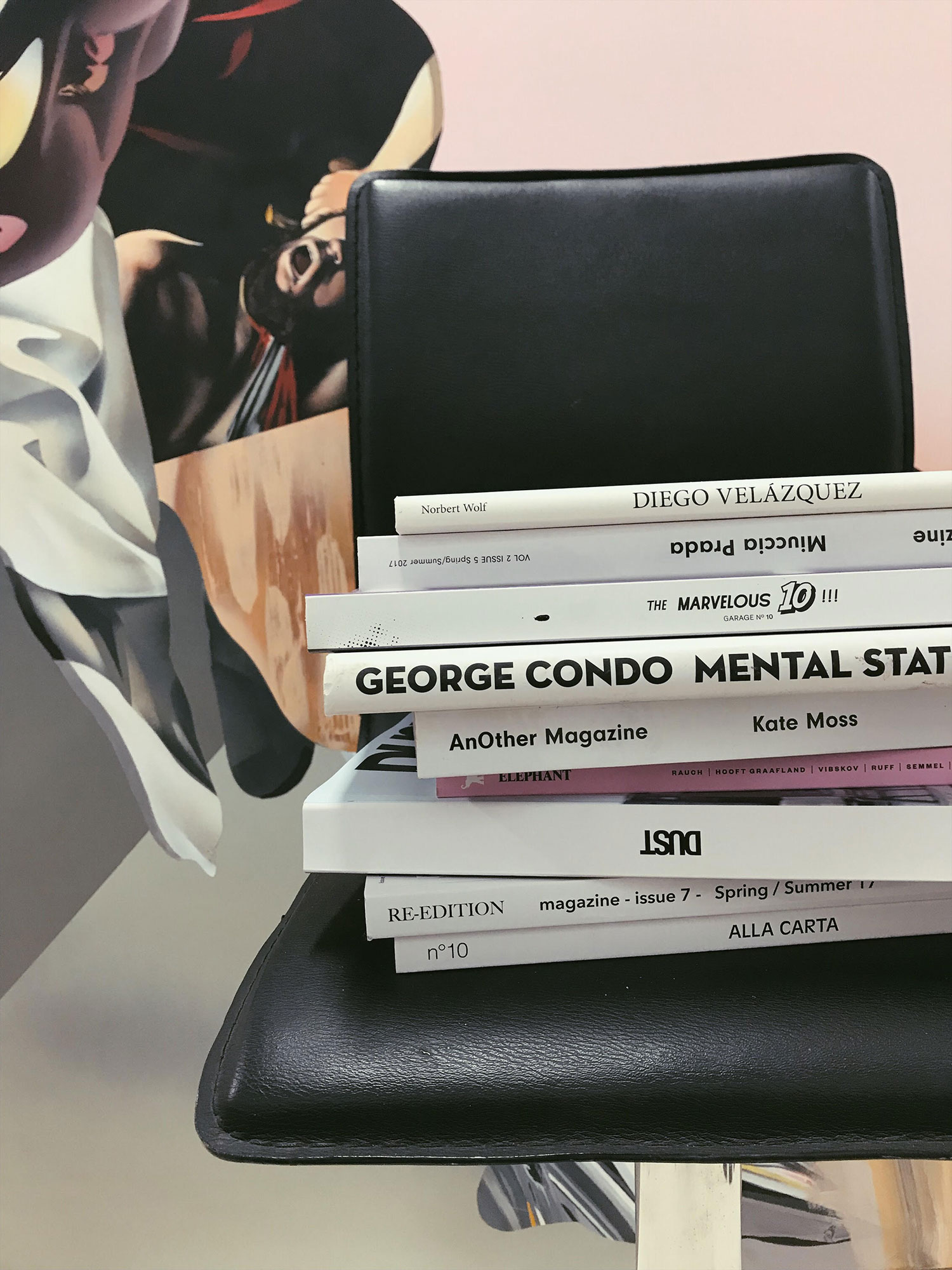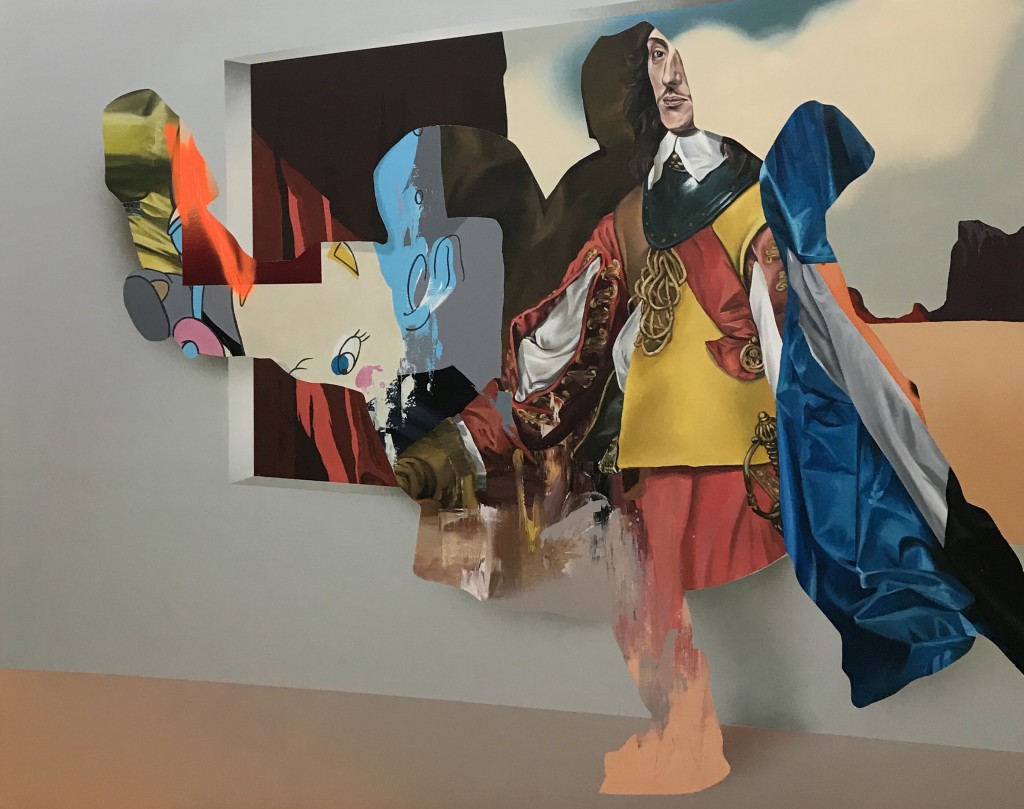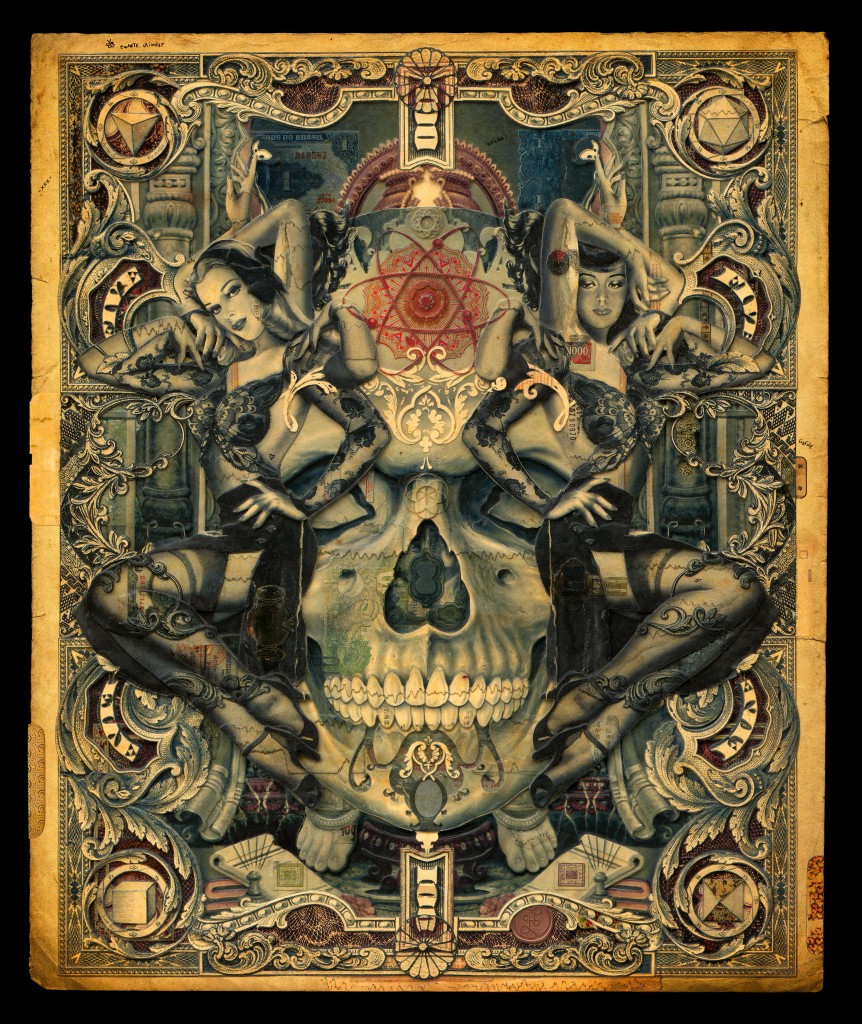Dutch artist Handiedan’s muses revel not in earthly delights. Instead, her re-imagined pin-up girls prevail on the curiosities of Quantum Physics and the mysteries of Sacred Geometries and Cosmology. Theirs is a game of complexity, not coquetry.
Handiedan draws on both digitally created and found components to assemble her highly- elaborate collage-based reliefs. These pin-ups are three-dimensional in every sense. Using the cut-and-paste method of re-assemblage, the artist painstakingly incorporates layer upon layer of material to raise the surfaces of the work, giving it a sculptural appeal.
Unfettered by any particular epoch of time, Handiedan also borrows across historical styles—from the Baroque to the Victorian to the post-war eras—and re-purposes what she finds. She culls an array of printed ephemera, planetary charts, international currencies, playing cards, seals, maps and vintage magazine images. The result: symbol-soaked compositions that read as part meditation, part diary entry, part cosmic puzzle.
Jonathan LeVine Projects, now housed at MANA Contemporary in Jersey City, has recently unveiled The Fourth Dimension: Time, Handiedan’s latest exhibition, and her debut solo show at the gallery. The new body of work continues on the artist’s signature trajectory of jaw-dropping sophistication and detail.
Handiedan is truly a one of one. MASS APPEAL linked up with the artist to learn more.
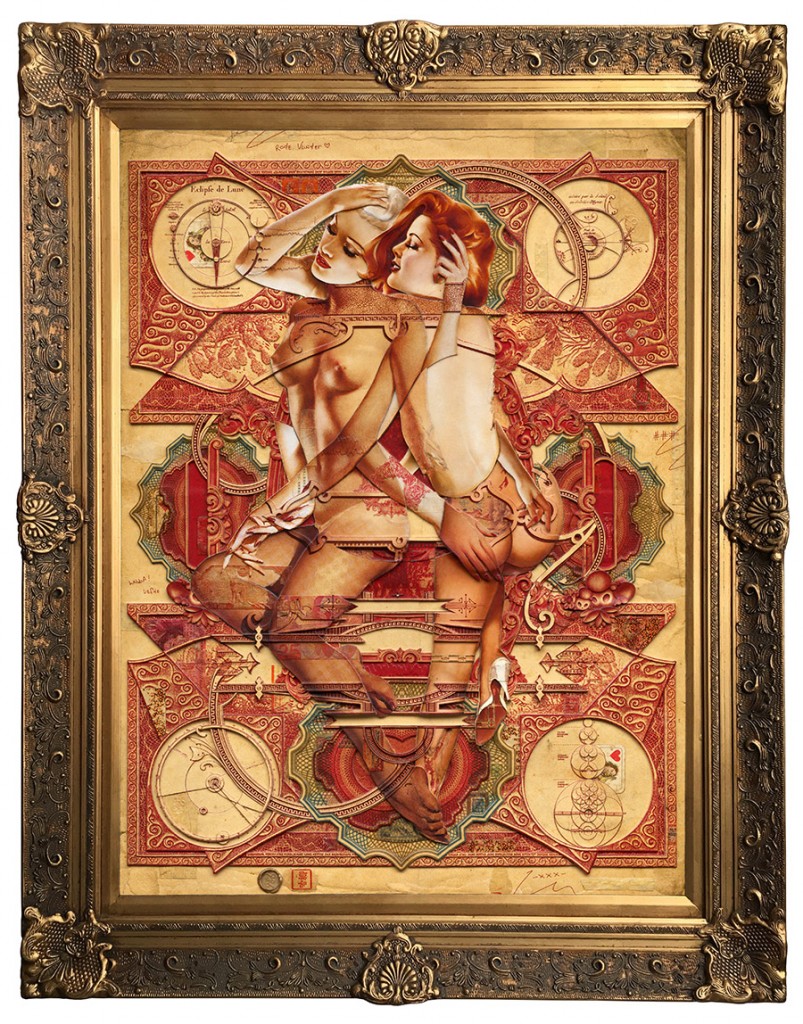
Let’s jump right into the power of the female gaze. The pieces are decidedly evocative and sexual, but also reverberate with intelligent. It’s not just pouty lips and rouged cheeks and curves. These women are also brandishing brains and spirit, and seemingly, are contemplating the sacred.
Yeah, there you go. The material that I use is actually the whole pinup thing. And I only use the old pinups because they are also a bit funny, like, “Oops, there goes my skirt!”Because back then that was super sexy, and now it’s like … not seen as risqué. And it’s also aesthetic. It’s part of culture, and shows how things change
What’s allowed, what’s not allowed.
Yes. I use the material, as almost the basis, and then I create something with more depth.
Who are these women to you?
Muses. But it’s also me, and also it’s personal. Or my love life, or maybe an imaginary person. But in the end, they represent an energy of strength and vulnerability. They also represent motion and time and change. You can see time, the passage of time, with the different poses in some of them. I studied photography. I love it when you have film stills and you put them on top of each other – to show action, by putting negatives on top of each other.
Aside from photography, what other practices have influenced you? What helped create your aesthetic?
I think it’s my curiosity. I think it’s natural. I always drew naturally, so I wanted to study, I wanted to got to art school, to learn something different. So, I did photography. Then I learned to work with computers and layers. And I noticed I always wanted to draw over the pictures. I started to find out that just one direction isn’t enough for me. I need to add something. So, I have this beautiful image, but what happens if I tear it apart and put it upside down? I think it’s a certain curiosity to refuel an existing image, or an image that has lived another life because of the old materials used. So, slowly, step by step, I thought, this is actually kind of cool.
What actually happened is that I had a little operation in 2006? Maybe ’07? It was not so serious, but I couldn’t move that much. My leg was not good for six weeks. But, I could work, so I canceled my freelance jobs and I was just, “Let’s put everything together I find fascinating.” That’s how it happened. This all started – and then I got this great response from people.
And still, if you ask me, “What is it?” I don’t know. But, I also I don’t wanna know. Because I have to think, if I know what it is, maybe I cannot create it anymore. It really is intuitive. When I’m in the flow and creating and then I finish, I sometimes step back and I think, “Oh, this is interesting, how did I do this?” It’s like I’m looking at it with almost new eyes.
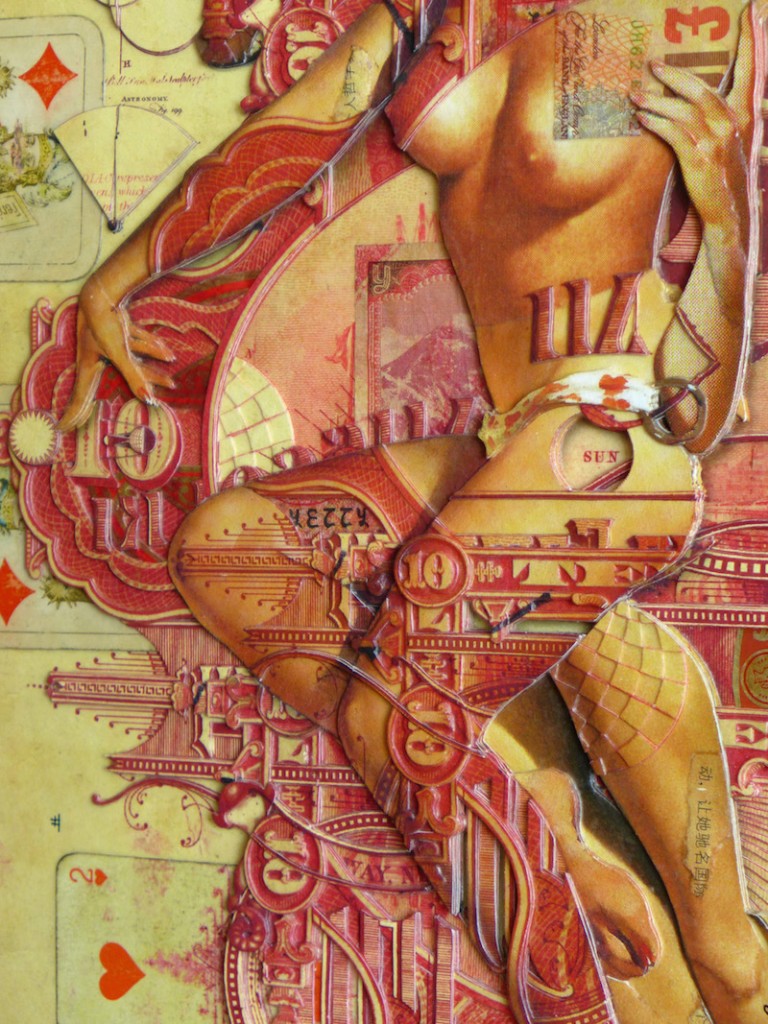
A poet said to me recently, “Don’t write the poem that you want to write. Write the poem that wants to be written.” When you begin work on a new piece, do you have a finished image in mind?
No. Not at all.
The piece tells you where it’s going?
Yes. Exactly. Gives direction.
From where are you sourcing all the different components?
I collect and people send me stuff, like notes and centerfolds, and that’s awesome because those are really hard to find in Europe. There’s also the web.
Once you’re in the flow and creating, does the actual act of “making” become meditative?
Yes, definitely. Definitely. It takes a long time. First I do everything digitally, and then print it out. It’s definitely meditation. And sometimes when I’m restless and I’m in a rush and I need to continue a piece and work on it every day, the process forces me to calm down, because I cannot cut faster than I can. So then it’s like, this really interesting …Sometimes even a little bit of an internal fight, because you are like, “I want to do this or that,” and you have all these ideas, and it makes you slow down and say, “Okay. Just these.”
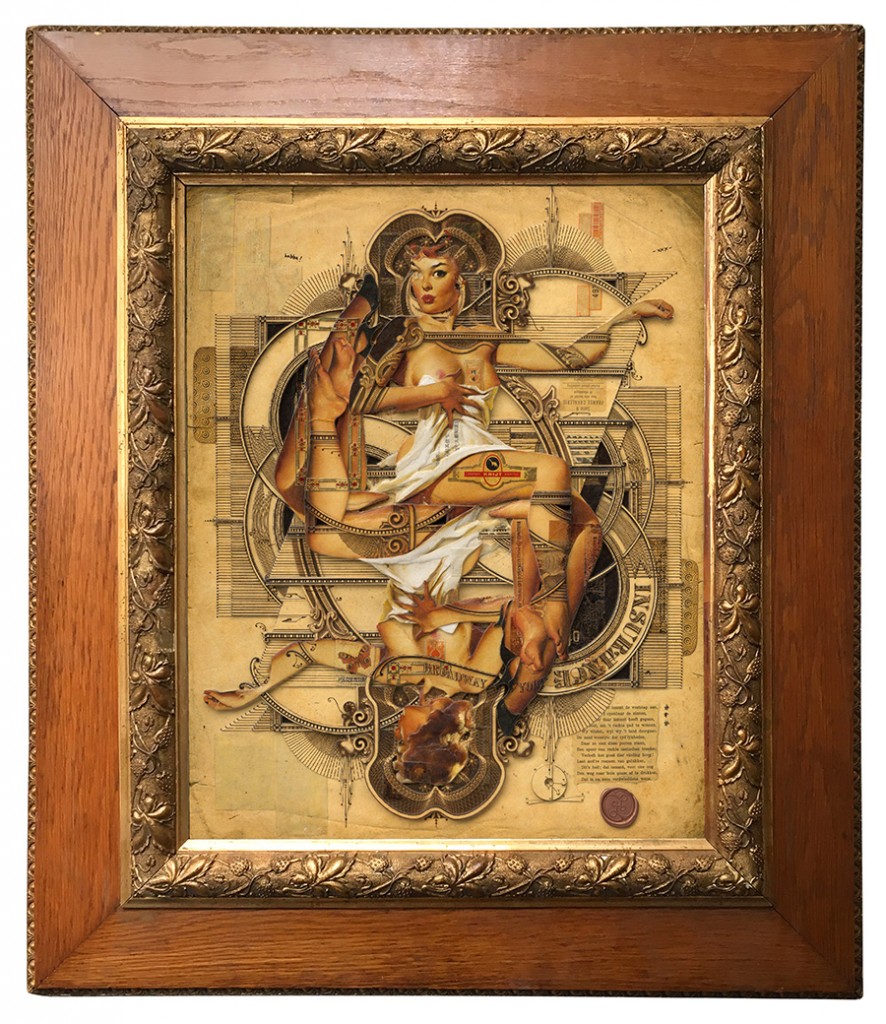
Your pieces have a sculptural component to them. The show’s title The Fourth Dimension: Time reminds me of a theater term—“breaking the fourth wall.” It’s as if the work is “breaking the fourth wall” of the picture frame and reaching across the divide to the viewer.
Yeah. Oh, that’s beautiful. I love that. Yeah, it’s definitely… The fourth dimension of time, for me, is also the way of working, the process of working. It can be fast, but also slow. It’s space and time. And in the fourth dimension, things can travel through time. So it’s time travel too, the ability to go back and forth.
And the analog and digital techniques you use further that time travel notion.
Yes. It’s always a combination. And absolutely, the materials are all literally from different times.
And in the work, you’ve almost created your own time.
Yeah! Like some little bubble somewhere. Its own special universe.
On average, how much time is spent creating a piece?
The designing of the image usually goes really fast, but it’ll be a long day. Maybe, sometimes in one day, I’ll have the image, and then the whole montage thing would take a couple of days, depending, maybe a week. I start in the morning, and then work through the night. Really, the whole image, the design of the image is really short. The whole cutting process will vary. On the smaller pieces, full-time, maybe two to three weeks of cutting. For the large pieces, closer to one and a half months.
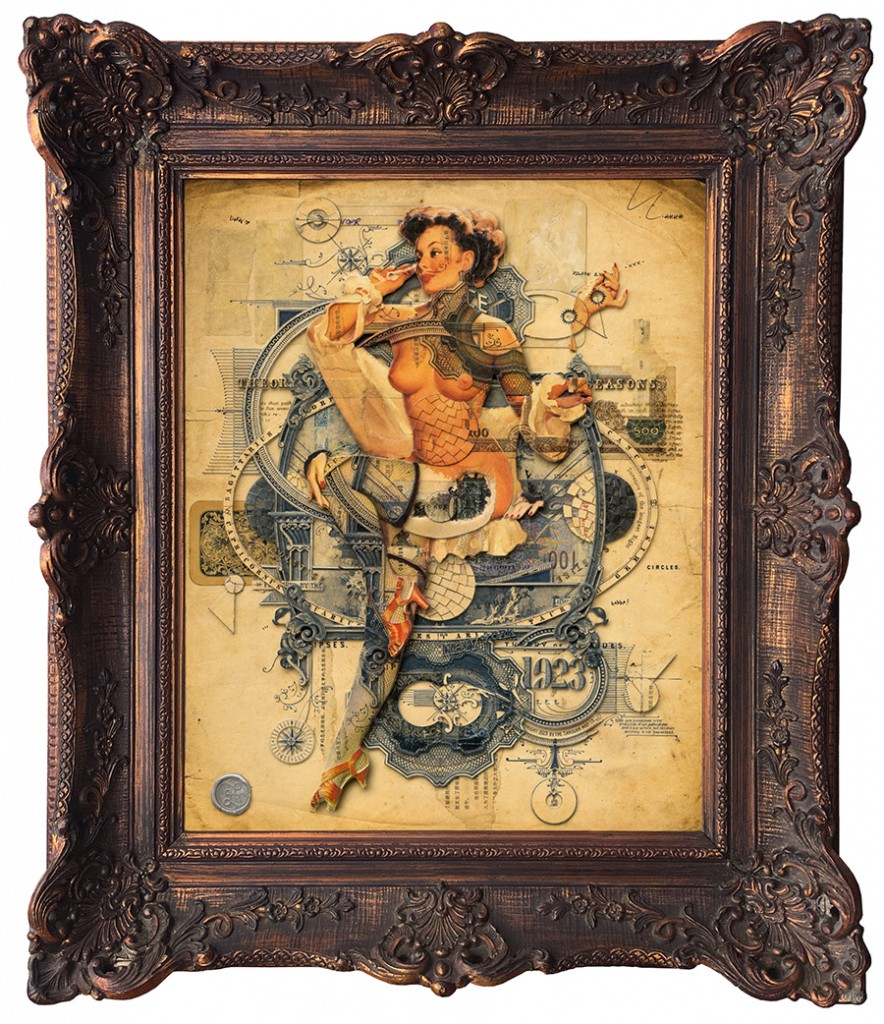
What has the work taught you along the way?
It’s an interesting question. I’ve learned a lot about myself. And again, still, I don’t know actually why I do this. In the first years, I was really unsure and insecure about it, and I questioned everything. And still, now, I don’t know why I do it. But it just … this (motioning to the work) happens. So maybe I’m like this portal, I don’t know. This happened, and it has developed. And I’m really grateful fo it. I’ve learned that I’m a collector and I have a really big eye for details and overview. Sometimes people step in my studio and they think it’s all paper and stuff, a lot of material. They might see it all as chaos. But, I see the structure. And (Laughs) I’m not afraid of losing stuff.
You are not particularly precious about every little detail?
No. I am really good at letting go. Of course, sometimes I paste something or I lose something and then I think, “Where is it?” And then I think, “Oh, that’s just meant to be.” So I try to really let go.
I mean there are so many possibilities to pursue. But I created this sort of framework that I can work within, where I can go crazy. But, there is still this framework with some rules. Rules with ornaments and the pinups and the use of currency, and of course new items come in, but I have this space. And that’s really safe for me to go crazy.
Would you describe this show as being your most personal work yet?
On one hand, yes. But on the other hand, it’s symbolic. My other pieces were also really … All my pieces are personal, of course. But now it was a little more… touchable for me. If you see the pieces from other shows, they are also really personal, but in a different way. I was more working as a scientist, and now it’s more … this is emotional.
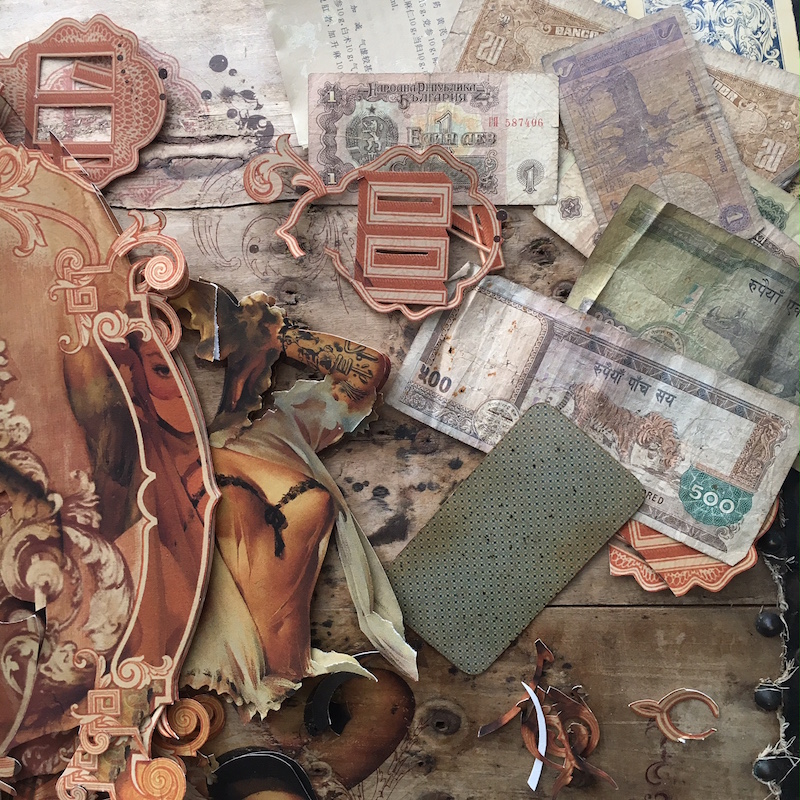
The Fourth Dimension: Time is on view at Jonathan LeVine Projects in Jersey City now through November 11th, 2017.




